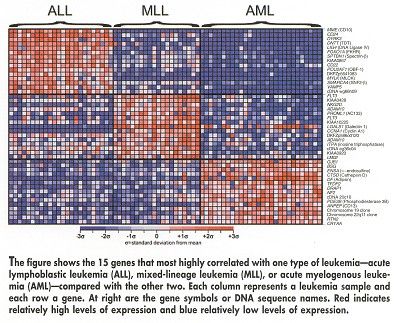Gene Chips Used to Identify Third Form of Pediatric Leukemia
BOSTON-A rare pediatric leukemia, previously thought to be a subset of acute lymphoblastic leukemia (ALL), is actually a distinct form of the disease, according to investigators who used gene chips to create and contrast genetic profiles of cancer cells.
BOSTONA rare pediatric leukemia, previously thought to be a subset of acute lymphoblastic leukemia (ALL), is actually a distinct form of the disease, according to investigators who used gene chips to create and contrast genetic profiles of cancer cells.
Scott Armstrong, MD, PhD, of Dana-Farber Cancer Institute, and his colleagues call the disease mixed-lineage leukemia (MLL) for a chromosomal translocation of the MLL gene.
Different Gene Expression Pattern
They reported in the January 2002 issue of Nature Genetics that the condition has a dramatically different pattern of gene expression from that of both ALL and acute myelogenous leukemia (AML), in addition to the distinguishing chromosomal translocation.
MLL affects infants in their first year; fewer than 100 babies annually are affected in the United States. It is especially aggressive, with recurrences leading to fatalities in about 60% of cases.
By 1999, a number of pediatric oncology groups had noticed that cells with the MLL translocation were more sensitive to cytarabine than other ALL cells, said Dr. Armstrong, who is also instructor in pediatric oncology, Harvard Medical School. The groups began experimenting with more intensive therapy than is standard for ALL, but have yet to determine whether outcomes are improved.
"You probably should think of treating MLL patients with hybrid therapy for ALL and AML," Dr. Armstrong told ONI. "We’re treating patients with a backbone of ALL therapy, but with much more cytarabine than normally would be used to treat ALL."
Genetic Profiles
Todd Golub, MD, of the Whitehead Institute/MIT Center for Genome Research, Cambridge, Massachusetts, worked with Dr. Armstrong, Stanley Korsmeyer, MD, of Dana-Farber, and the other authors to create genetic profiles (showing which genes are active or inactive) of ALL, AML, and MLL on gene chips.
The chips are wafers of glass or silicon with more than 12,000 DNA segments attached. They are used to probe RNA from cancer cells taken from tissue samples to determine which genes are being expressed.

The team found about 1,000 genes that were exceptionally active in ALL but silent in MLL. Conversely, about 200 genes were overactive in MLL cells but silent in ALL. Both ALL and MLL had a different expression pattern from that of AML (see Figure). "To our knowledge," the authors wrote, "this is the first whole-genome profiling study to show that a chromosomal translocation can specify a unique gene expression profile."
High Expression of FLT3
In a finding with potential clinical significance, the MLL genetic profile shows high-level expression of the FLT3 gene, which produces tyrosine kinase, an enzyme that promotes cell growth.
"That molecule is thought to be important in the development of AML, and drugs against activation of that molecule will soon be in phase II trials for adults with AML," Dr. Armstrong said, adding that one in five AML patients has a mutation activating FLT3.
He predicts that FLT3 inhibitors will be ready for clinical trials in children "within the next couple of years."
Gene chip technology is not yet available for oncologists to use in diagnosing MLL, but the disease’s distinguishing chromosome abnormality can easily be identified with standard cytogenetics, Dr. Armstrong said.
Other telltale signs, he said, are a diagnosis of ALL but with a very high white blood cell count at presentationwell over 100,000and the absence of the ALL antigen CD10. "These cells do not express CD10," he said. "That difference is probably the first tip that the patient likely has this type of leukemia."
Newsletter
Stay up to date on recent advances in the multidisciplinary approach to cancer.